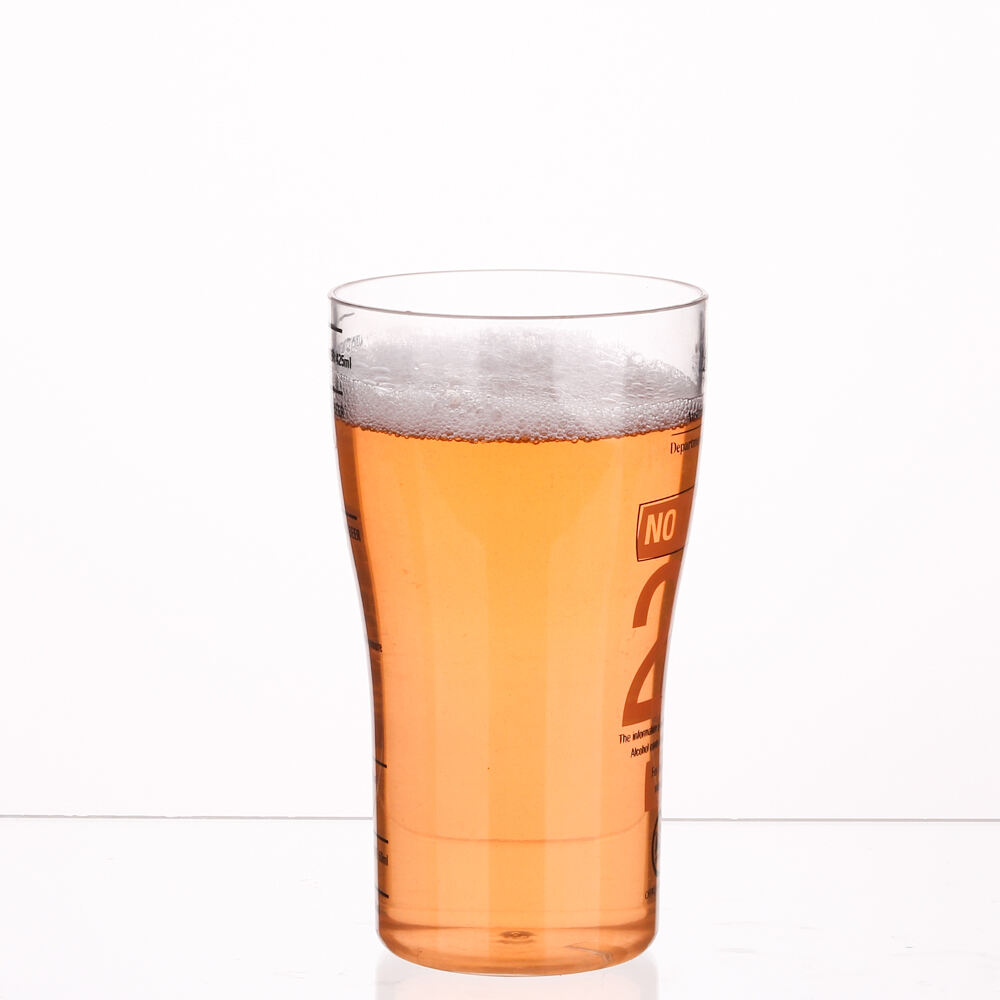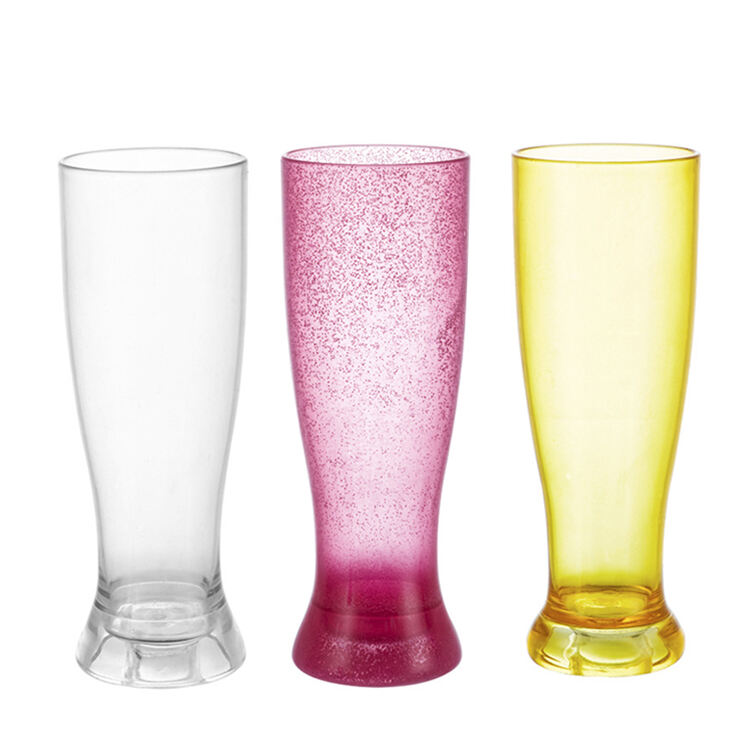How Glass Thickness Impacts Temperature Control and Beer Enjoyment
Heat Transfer and Insulation Properties of Beer Glass Thickness
The thickness of glass actually affects how cold beer stays because of the way heat moves through it. Studies show that thicker glasses in the range of about 3.5 to 5 millimeters can cut down on heat transfer from the surroundings by roughly 12 to 18 percent compared with thinner ones around 1.5 to 2.5 mm thick. The American Society of Brewing Chemists did some thermal analysis back in 2023 confirming this effect. While these heavier glasses do keep temperatures more stable over time, they aren't so great at getting the beer cold quickly right after opening, usually taking about 5 to 7 degrees Fahrenheit longer to chill properly.
Impact of Thick vs. Thin Glasses on Maintaining Optimal Drinking Temperature
A 2022 beverage thermodynamics study revealed distinct performance differences:
| Glass Type | Initial Chill Retention (10 mins) | 30-Minute Warming Rate |
|---|---|---|
| Thick (4mm) | 38°F – 43°F (+5°F) | +12°F/hour |
| Thin (2mm) | 36°F – 47°F (+11°F) | +18°F/hour |
Thick glasses perform better in warm environments (75°F+), preserving coldness longer, while thin glasses are ideal for quick consumption in cooler settings due to faster chill-down and lighter handling.
Case Study: Temperature Retention in Pilsner vs. Stout Glasses Over 30 Minutes
A 2024 Brewers Association trial compared two standard designs:
- Pilsner Glass (3mm thickness): Maintained lager between 41–48°F
- Stout Glass (5mm thickness): Held stout at 48–53°F
The 1.3x thicker stout glass showed 22% slower heat absorption, aligning with dark beers’ preferred serving range (45–55°F). Its thermal inertia is especially effective in high-traffic pub environments where ambient heat exposure is frequent.
The Influence of Glass Thickness on Aroma, Flavor, and Sensory Perception
How Glass Thickness Affects the Release of Volatile Compounds and Aromatic Intensity
Glass thickness makes a real difference when it comes to keeping beer tasting great. Thicker glass creates a better barrier between hands and beer, so less heat gets transferred and those important aroma compounds stay intact longer. Studies show that glasses with walls thicker than 2 mm hold onto their aromas about 15% better after sitting for 10 minutes compared to thin glasses. But there's a catch worth mentioning. If the glass is way too thick (around 3.5 mm or more), it might actually block oxygen from reaching the surface of the beer. This can sometimes mute those subtle hop flavors or fruity esters we love in IPAs and wheat beers. Finding that sweet spot in glass thickness really matters for enjoying all the flavors a brew has to offer.
The Role of Rim Thickness in Flavor Delivery and Head Formation
Rim thickness plays a key role in both foam stability and flavor delivery:
- Foam stability: Rims ≤1 mm create smoother pour angles, reducing CO₂ disruption and sustaining a 1.5 cm head for 8–10 minutes.
- Flavor focus: Rims exceeding 1.5 mm narrow the drinking aperture, directing aromas toward the nose and optimizing liquid dispersion across the tongue for enhanced taste perception.
Multi-Sensory Experience: How Sight, Smell, and Touch Interact in Beer Tasting
Glasses with thick walls actually make people feel something different when they hold them. The extra weight somehow tells our brains these are better quality drinks. Studies show interesting results too - when the same beer is poured into a 400 gram glass compared to just 200 grams, folks think it tastes richer about 22% more often. On the flip side, those thinner parts of glasses let us see through better. We can watch bubbles rise and notice colors more clearly, which makes everything look fresher. Because of how all these senses work together, lots of small breweries now pick specific glass types for each kind of beer they make. IPA gets one shape, stout another, so customers always get that same great experience no matter what they order.
Glass Weight and Tactile Feedback: Enhancing Perceived Mouthfeel

How Thicker, Heavier Glasses Influence the Perception of Beer Body and Richness
The weight and thickness of a glass shape sensory expectations before tasting. Thicker-walled designs (2.5–3.5 mm) increase the perceived body of beer by 23%, driven by:
- Thermal inertia: Consistent hand contact maintains stable beer temperature, preventing rapid shifts that alter mouthfeel.
- Haptic feedback: Glasses weighing 400–600 grams activate pressure receptors linked to perceptions of substance and quality.
In blind tastings, stouts in thick mugs are rated 19% creamier, while pilsners in 2mm vessels score higher in crispness—demonstrating how physical cues directly influence flavor interpretation.
Psychological Impact of Glass Weight on Drinker Satisfaction and Quality Perception
Oxford research shows beers in heavier glasses are perceived as 31% more premium, even when identical in content. This "weight-value heuristic" operates through several factors:
| Factor | Impact on Perception |
|---|---|
| Glass weight (grams) | +18% perceived quality per 100g increase |
| Center of gravity | Lower positioning = +14% "smoothness" ratings |
| Rim thickness | 2.8mm optimal for balancing drinkability and luxury signaling |
Recent neuroscience findings show heavier glasses activate the orbitofrontal cortex 22% more intensely—the brain region tied to premium experiences—further reinforcing the link between touch and taste.
Material and Design: Balancing Thickness for Durability and Functionality
Common Materials (Borosilicate, Crystal) and Their Relationship with Glass Thickness
Borosilicate glass dominates commercial production due to its durability and resistance to thermal shock, performing well at 1.8–3.2mm thickness. Crystal glass offers superior optical clarity but requires thinner construction (1.2–2mm), making it more prone to damage—research shows crystal beer glasses fracture 37% faster than borosilicate during repeated washing cycles.
Durability Tradeoffs: Thick vs. Thin Glasses in Commercial and Home Settings
Glasses with 3mm walls typically survive 200+ dishwasher cycles under NSF International standards, though they weigh 42% more than 2mm variants. Commercial venues favor thicker designs (2.5–3mm) to minimize breakage costs, while home users often prefer 2mm options for lighter handling, despite an 18% higher chipping risk over five years.
Glass Thickness Standards and Manufacturing Considerations
The ISO 7458 standard sets requirements that beer glasses must handle around 300 Newtons of vertical force, which means borosilicate glass needs at least 2mm thickness to meet these specs. Recent improvements in laser technology have made it possible to cut stemware with incredible accuracy down to about 0.1mm increments. This lets designers create better transitions between different thicknesses while still keeping the glass strong enough. According to some industry research, roughly seven out of ten craft breweries work directly with glass manufacturers when creating their signature glass shapes. They're looking for that sweet spot where the glass can survive regular use but also enhances how customers experience the beer's aroma and taste.
Best Glass Thickness Recommendations by Beer Style and Usage
Ideal Glass Thickness for Pilsners, Stouts, Wheat Beers, and IPAs
The right glass thickness really matters for getting the most out of different beers. Take crisp pilsners for instance they're usually served between 38 and 45 degrees Fahrenheit (or about 3 to 7 Celsius) and work best in thinner glasses around 2 to 3 millimeters thick. These thinner glasses help keep the carbonation intact and make the beer feel more refreshing on the palate. When it comes to stouts, folks tend to prefer them a bit warmer, somewhere between 50 and 55 degrees Fahrenheit (10 to 13 Celsius). For these darker brews, thicker glass walls measuring 4 to 5 mm actually do something good they slow down how fast the beer warms up during drinking. Wheat beers find their sweet spot in mid range glasses, about 3 to 4 mm thick, since this helps maintain proper foam levels while keeping temperatures stable enough. And modern IPA glasses have gotten pretty clever too, with those 3.5 mm tapered rims designed specifically to trap those intense hop aromas right where they belong, all without letting the drink get too warm too quickly.
| Beer Style | Ideal Thickness | Temperature Maintenance (30-min test)* | Key Consideration |
|---|---|---|---|
| Pilsner | 2-3mm | 87% chill retention | Preserve carbonation |
| Stout | 4-5mm | 92% heat retention | Slow temperature increase |
| Wheat Beer | 3-4mm | 84% chill retention | Support foam formation |
| IPA | 3-4mm | 81% chill retention | Balance aroma & temperature |
*Based on 2025 comparative analysis of commercial glassware
Craft Brewery Trends: Prescribing Specific Glassware for Sensory Optimization
More than two thirds of craft breweries are now matching their signature brews with specific types of glassware after studies showed that when beer is served in properly matched glasses, people actually taste better flavors about a quarter more often. The folks making those cloudy IPAs love big mouthed glasses where the sides are around 3mm thick because it really brings out those tropical fruit and citrus smells. On the other hand, brewers who make those rich stouts aged in barrels tend to go for smaller snifter glasses holding about six to eight ounces with thicker bottoms around 4.5mm. These glasses let the beer warm up slowly which helps concentrate all those complex aromas that come through as the drink warms up a bit.
Practical Tips for Consumers: Choosing, Cleaning, and Maintaining Beer Glassware
Selection Priorities
Match thickness to your preferred styles: thin for lagers, moderate for ales. Avoid decorative thick bases that add weight without thermal benefits.Cleaning Protocol
Handwash glasses over 3mm thick with soft sponges to prevent micro-scratches. Never freeze thick-walled glass—thermal shock can cause stress fractures.Longevity Practices
Rotate frequently used glasses to distribute wear evenly. Discard cloudy or etched glasses, as mineral buildup impairs thermal performance and visual appeal.
Optimal glass weight for a 12oz serving ranges between 140–180g—substantial enough to convey quality, yet light enough to avoid hand fatigue during extended enjoyment.
FAQ
How does glass thickness affect the temperature of beer?
Thicker glass (3.5 to 5 mm) reduces heat transfer from the surroundings, keeping beer colder longer compared to thinner glass (1.5 to 2.5 mm).
What is the optimal glass thickness for different types of beer?
Pilsners do best in 2-3 mm thick glasses, stouts in 4-5 mm, wheat beers in 3-4 mm, and IPAs in 3-4 mm glasses for optimal temperature and aroma retention.
Does the thickness of the glass impact the taste and aroma of beer?
Yes, thicker glasses maintain aroma compounds longer by minimizing heat transfer. However, overly thick glasses may block oxygen, affecting flavor notes in certain beers.
How does glass weight influence the perception of beer quality?
Heavier glasses are perceived as more premium, enhancing the drinker’s satisfaction and perceived quality of the beer.
Table of Contents
- How Glass Thickness Impacts Temperature Control and Beer Enjoyment
- The Influence of Glass Thickness on Aroma, Flavor, and Sensory Perception
- Glass Weight and Tactile Feedback: Enhancing Perceived Mouthfeel
- Material and Design: Balancing Thickness for Durability and Functionality
- Best Glass Thickness Recommendations by Beer Style and Usage
- FAQ

